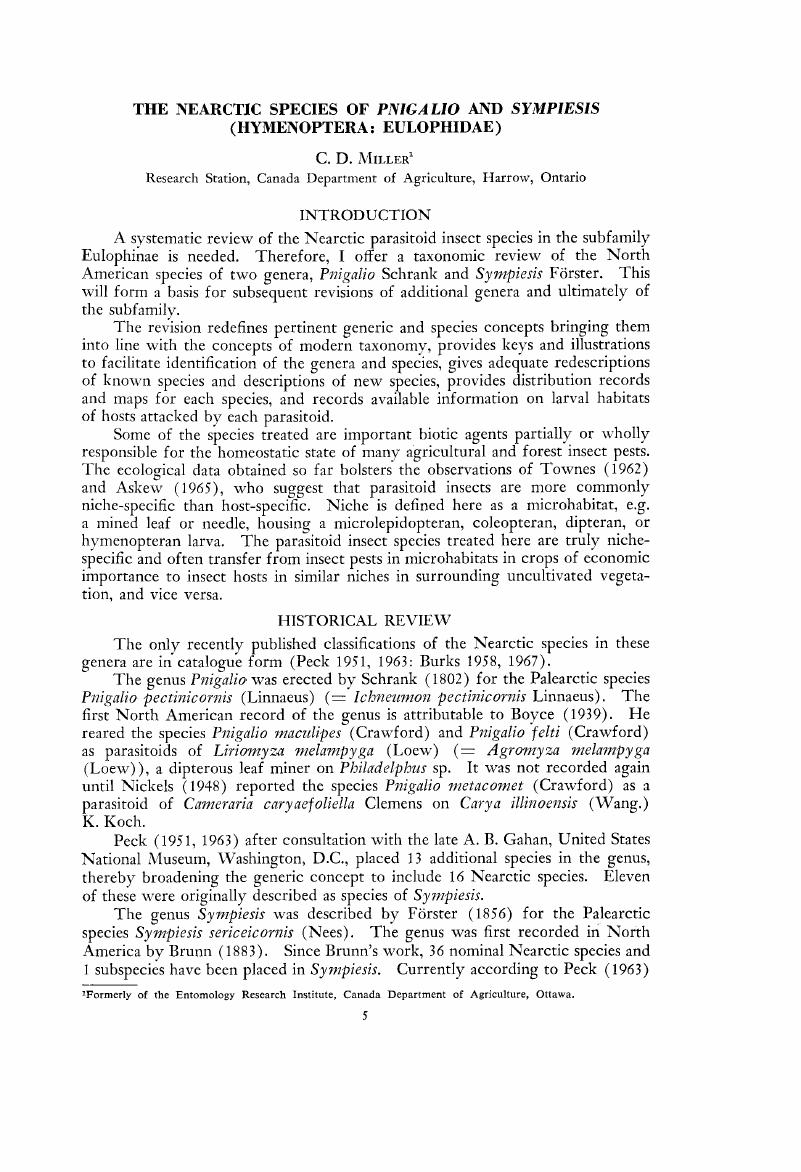Crossref Citations
This article has been cited by the following publications. This list is generated based on data provided by Crossref.
Hennessey, R. D.
1981.
Setal patterns of the wings ofAphelinus, Mesidia, andMesidiopsis [hym.: aphelinidae], their values as taxonomic characters.
Entomophaga,
Vol. 26,
Issue. 4,
p.
363.
HANSSON, CHRIS TER
1996.
A new genus of Eulophidae (Hymenoptera: Chalcidoidea) with remarkable male genitalia.
Systematic Entomology,
Vol. 21,
Issue. 1,
p.
39.
UBAIDILLAH, Rosichon
LASALLE, John
QUICKE, Donald L. J.
and
KOJIMA, Jun‐ichi
2003.
Cladistic analysis of morphological characters in the eulophine tribe Cirrospilini (Hymenoptera: Eulophidae).
Entomological Science,
Vol. 6,
Issue. 4,
p.
259.
Bernardo, Umberto
Pedata, Paolo Alfonso
and
Viggiani, Gennaro
2006.
Life history of Pnigalio soemius (Walker) (Hymenoptera: Eulophidae) and its impact on a leafminer host through parasitization, destructive host-feeding and host-stinging behavior.
Biological Control,
Vol. 37,
Issue. 1,
p.
98.
Bernardo, U.
Pedata, P.A.
and
Viggiani, G.
2007.
Phenotypic plasticity of pigmentation and morphometric traits inPnigalio soemius(Hymenoptera: Eulophidae).
Bulletin of Entomological Research,
Vol. 97,
Issue. 1,
p.
101.
Gebiola, M.
Bernardo, U.
Monti, M. M.
Navone, P.
and
Viggiani, G.
2009.
Pnigalio agraules(Walker) andPnigalio mediterraneusFerrière and Delucchi (Hymenoptera: Eulophidae): two closely related valid species.
Journal of Natural History,
Vol. 43,
Issue. 39-40,
p.
2465.
Digweed, Scott C.
MacQuarrie, Chris J.K.
Langor, David W.
Williams, Daryl J.M.
Spence, John R.
Nystrom, Kathryn L.
and
Morneau, Louis
2009.
Current status of invasive alien birch-leafmining sawflies (Hymenoptera: Tenthredinidae) in Canada, with keys to species.
The Canadian Entomologist,
Vol. 141,
Issue. 3,
p.
201.
GEBIOLA, M.
GÓMEZ‐ZURITA, J.
MONTI, M.M.
NAVONE, P.
and
BERNARDO, U.
2012.
Integration of molecular, ecological, morphological and endosymbiont data for species delimitation within thePnigalio soemiuscomplex (Hymenoptera: Eulophidae).
Molecular Ecology,
Vol. 21,
Issue. 5,
p.
1190.
Gebiola, Marco
Bernardo, Umberto
Ribes, Antoni
and
Gibson, Gary A. P.
2015.
An integrative study ofNecremnus Thomson (Hymenoptera: Eulophidae) associated with invasive pests in Europe and North America: taxonomic and ecological implications.
Zoological Journal of the Linnean Society,
Vol. 173,
Issue. 2,
p.
352.
Gupta, Ankita
Gawas, Sandesh M.
and
Bhambure, Ravindra
2015.
On the parasitoid complex of butterflies with descriptions of two new species of parasitic wasps (Hymenoptera: Eulophidae) from Goa, India.
Systematic Parasitology,
Vol. 92,
Issue. 3,
p.
223.
Huber, John
Bennett, Andrew M
Gibson, Gary
Zhang, Y. Miles
and
Darling, Chris
2021.
Checklist of Chalcidoidea and Mymarommatoidea (Hymenoptera) of Canada, Alaska and Greenland.
Journal of Hymenoptera Research,
Vol. 82,
Issue. ,
p.
69.
Kosheleva, O. V.
2023.
A new remarkable species of Pnigalio Schrank, 1802 (Hymenoptera: Chalcidoidea: Eulophidae) from the Altai Mountains, Russia.
Euroasian Entomological Journal,
Vol. 22,
Issue. 3,
p.
159.





